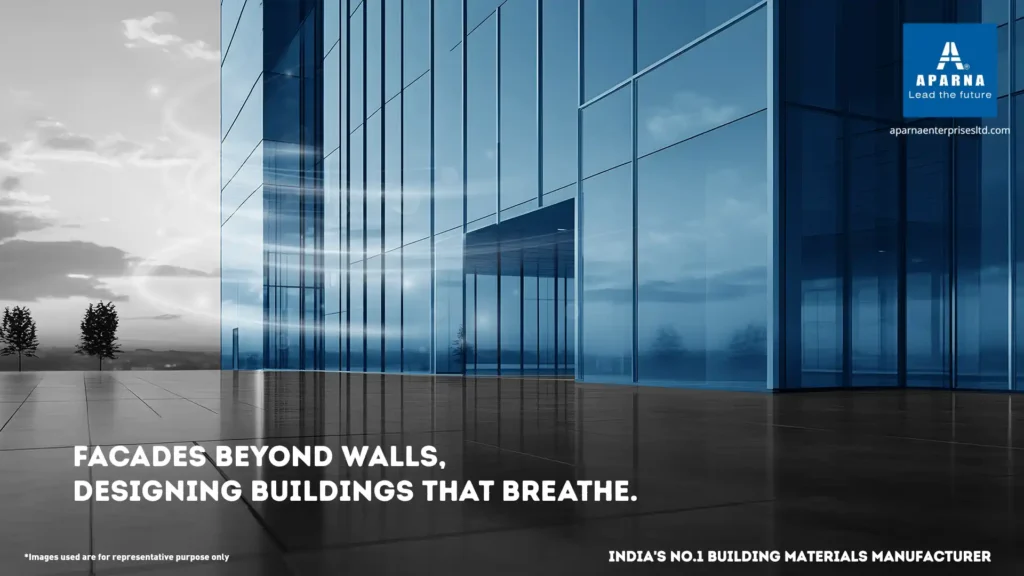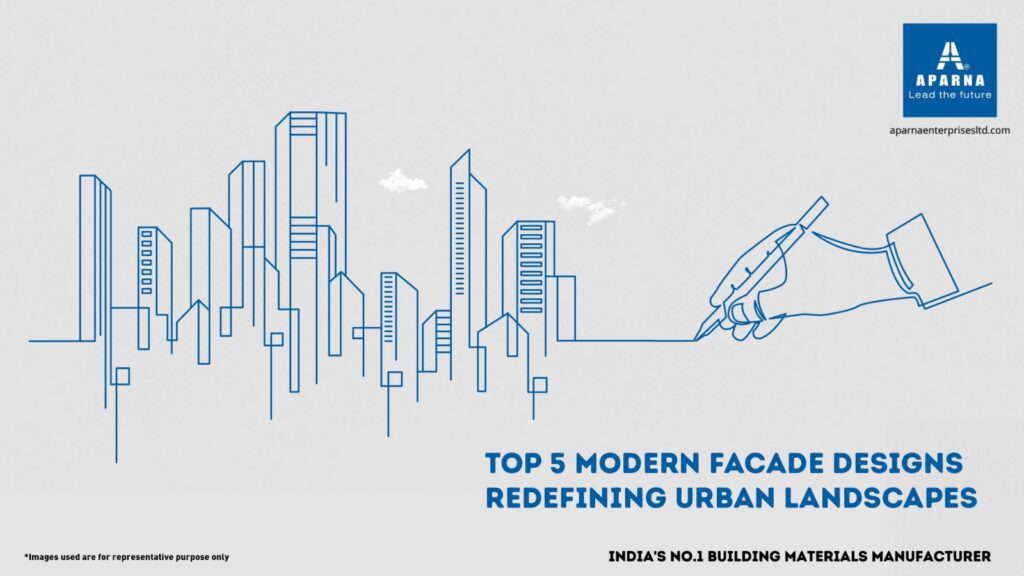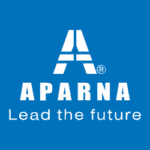Tag: exterior facade design
Facades Beyond Walls. Designing Buildings That Breathe.

The typical stereotype of viewing a building facade as a protective shield against the elements is transforming and shifting to a whole new paradigm. Presently, visionary architects and pioneering materials manufacturers such as Aparna Enterprises Ltd., are refashioning building facades design to build marvellous structures that engage and adapt with their surroundings. These “breathing” buildings lay the foundation of natural light and airflow which helps establish a coherent relationship between indoor and outdoor spaces. This in turn promotes healthier and more sustainable urban environments.
The factor that is spearheading this transformation is the intelligent use of materials like glass, expertly engineered into sophisticated systems. From expansive glass facades that flood interiors with daylight to intricate suspended glass assemblies that redefine spatial flow, glass is no longer just a window – it’s a dynamic element in creating architecture that truly lives.
The Transparency and Lightness of Glass Facades
For a good reason, glass facades have become a staple of modern architecture because of their sublime aesthetics. The transparent flow of natural light deep into the building interiors, and glass facades provides transparency reducing the need for artificial illumination, and creating bigger, brighter and more energising spaces.
- Maximizing Natural Light: A well-designed glass facade building adds an additional layer of visual appeal by strategically orienting and specifying high-performance glass. They also contribute significantly to energy efficiency and architects can optimise reliance on artificial lighting during the day.
- Connecting with the Outdoors: Depending on the vision, glass facades blend the interior and exterior seamlessly creating unobstructed views of the urban landscape. This adds to the well-being aspect of the structure and creates a more dynamic indoor environment.
- Aesthetic Versatility: From sleek, minimalist designs to bold, sculptural expressions, glass facades offer immense aesthetic versatility. Advancements in glass technology, including various tints, coatings, and structural capabilities, allow architects to realize their most ambitious visions.
The Elegance and Engineering of Curtain Wall Glazing
Currently, glass curtain walls are a splendid and sophisticated approach to facade design, for those who have a specific taste. They offer a lightweight, non-structural external covering that gives aesthetic flexibility with supreme performance.
- Seamless Integration: The smooth and seamless surfaces of glass lend a contemporary elegance to the urban architecture that often features curtain wall glazing systems and suspended glass assemblies.
- Performance and Efficiency: Curtain wall glazing systems of today incorporate advanced technologies for better efficiency, thermal insulation, and acoustic performance. High-performance glass, coupled with carefully engineered framing systems, ensures occupant comfort and reduces energy consumption.
- Design Freedom: Glass curtain walls allow for the creation of complex and dynamic architectural canopies and building forms. The ability to integrate various types of glass and infill panels provides architects with immense design freedom to shape the visual identity of a structure.
Beyond Vertical Walls: Innovative Glass Applications
The adaptable factor of glass contributes beyond the typical facades, adding on to the “breathing” capabilities of the structure in innovative ways.
- Modern Skylights: Modern skylights bring natural light into the deepest parts of a building, often transforming dimly lit spaces into vibrant surroundings that feel sensational. Often utilizing frameless glass roofs, these openings enhance natural ventilation that feels unusually vibrant.
- Architectural Canopies: Elegant glass canopies define the entrance of a structure, creating a welcoming atmosphere and smoothly transitioning into the rest of the spaces. Their lightweight and transparent nature not only provides shelter but also minimizes visual obstruction.
- Suspended Glass Assemblies: Beyond curtain walls, suspended glass assemblies can create dramatic interior and exterior features, such as glass walkways, partitions, and even secondary facade layers that allow for airflow and light diffusion.
Engineering Facades That Breathe
At Aparna Enterprises Ltd., our commitment to innovation and quality drives us to provide cutting-edge facade solutions that embody the principles of “breathing” architecture. Through our expertise in glass facades, including sophisticated glass curtain walls and elegant architectural canopies, we empower architects and developers to create buildings that are not only visually stunning but also environmentally responsible and enhance the well-being of their occupants. Our focus on precision engineering and high-performance materials ensures that our facade systems contribute to energy efficiency, natural light optimization, and a seamless integration with the urban environment.
The future of building facades design lies in creating structures that transcend the concept of static barriers. By embracing the possibilities of glass facades, innovative curtain wall glazing, and other dynamic glass applications, we can design buildings that truly breathe – maximizing natural light and ventilation, fostering a connection with the outdoors, and ultimately creating healthier, more sustainable, and more vibrant urban environments. Aparna Enterprises Ltd. is proud to be at the forefront of this evolution, engineering facades that not only define the skyline but also enhance the very experience of urban living.
Top 5 Modern Facade Designs Redefining Urban Landscapes

Modern facade designs are evolving the aesthetics of cities on a holistic and aesthetic perspective, a canvas that is always changing. The facade speaks more than what meets the eye; it is a strong statement that reflects the architectural vision and shapes our cities’ own identities. We are at Aparna Enterprises Ltd. (AEL) are aware of the supreme influence that skillfully designed facades may have. Our brand, Aparna-Craft, allows developers and architects to bring their visions to life. Discover five innovative modern facade design ideas that are transforming the way we construct and see urban architecture in addition to being aesthetically pleasing.
1. The Elegance of Integrated Glazing Systems
One of the primary defining characteristics of modern architecture is the smooth use of glass for a building’s exterior. From the smooth flow of natural light and energy efficiency, producing aesthetically beautiful surfaces, advanced glazing technologies have several advantages.
- Floor-to-ceiling glass facades: These designs blur the lines between indoor and outdoor spaces, offering panoramic views and a sense of openness despite being a high-rise structure. High-performance glass options, often used in systems like those offered by Aparna Craft, provide excellent thermal insulation and acoustic dampening, ensuring comfort without compromising on aesthetics.
- Curtain wall systems: Expertly designed by companies like Aparna-Craft, these non-structural external walls offer a great deal of architectural versatility. They allow architects to develop complex and aesthetically striking architectural facade designs by accommodating a variety of infill panels, such as glass, metal, and stone. Long-term durability and weather resistance are guaranteed by precision engineering.
- Dynamic glazing: Dynamic glass is a fascinating development in exterior facade design that can change its transparency in reaction to sunlight, lowering heat gain and glare. This intelligent technology is a progressive approach to modern facade design architecture that improves occupant comfort and energy efficiency.
2. The Art of Metal Cladding: Boldness and Versatility
Metal cladding is a popular option for creative building exterior designs because of its remarkable endurance and eye-catching appearance. The options are almost endless, ranging from textured steel to elegant aluminum panels.
- Aluminum composite panels (ACP): These lightweight yet rigid panels, often featured in Aparna-Craft solutions, provide a smooth, contemporary look and can be easily shaped and formed into complex geometries. Their versatility allows for the creation of visually arresting facade design ideas.
- Profiled metal sheets: Profiled metal cladding offers superior weather resistance and lifespan, along with a more elegant yet industrial look. Varying the profiles and finishes can produce a variety of visual effects, giving the facade building design more depth and texture.
- Expanded and perforated metal: In addition to adding visual interest, these materials can have practical uses, including ventilation or shade. Their distinct patterns and textures add to the art of architectural facade design.
3. The Timeless Appeal of Natural Stone and Terracotta
Many architects are embracing modernity while yet finding inspiration in organic materials such as terracotta and stone. These materials give building facade designs a feeling of texture, warmth, and permanence.
- Stone cladding: Stone cladding, whether in the form of massive granite panels or rustic limestone, adds a feeling of permanence and classic style. It is a suitable option for modern facade design architecture since modern installation methods guarantee longevity and ease of maintenance.
- Terracotta panels and tiles: Terracotta features provide building exteriors, warmth and character with their tactile textures, rich and earthy tones. Contemporary terracotta solutions provide enhanced durability and architectural versatility, enabling imaginative exterior facade design.
4. The Green Revolution: Living Facades
Growing demand for more sustainability and better urban settings is fueling the trend of incorporating vegetation into building facades. Green walls, sometimes referred to as living facades, have several advantages over just being aesthetically pleasing.
- Vertical gardens: These systems involve planting vegetation directly onto the facade, creating a living, breathing skin for the building. They can improve air quality, reduce the urban heat island effect, provide insulation, and enhance biodiversity, representing truly innovative building facade designs.
- Living walls with modular systems: These systems make use of pre-grown modules or panels that are affixed to the exterior of the structure. They are a sensible choice for large-scale facade design architecture since they provide more control over the choice and upkeep of the plants. Unquestionably, a flourishing green facade has a transforming visual impact.
5. The Precision of Modular and Prefabricated Facades
Modern construction demands speed and efficiency, and modular and prefabricated facade systems provide several benefits in this area. Aparna Enterprises Ltd. directly met this demand for accuracy and quicker building schedules with its cutting-edge Aparna-Craft solutions.
- Unitized curtain wall systems: Aparna-Craft provides these complex facade solutions that enhance a building’s functioning while capturing its personality. Under strict quality control, these sizable, pre-assembled units, which frequently include glazing and other facade components, are produced off-site and quickly mounted on the building frame. This technique ensures excellent quality while drastically cutting down on-site construction time. Curtain wall systems by Aparna-Craft are adaptable, fire and weather-resistant, and energy-efficient. They are also lightweight and soundproof. Mostly made of glass and aluminum, they provide a great deal of architectural flexibility while lowering the building’s structural load.
- Prefabricated panel systems: Off-site manufacturing of sturdy yet lightweight panels in a range of shapes, sizes, and finishes is made possible by Aparna-Craft’s proficiency with aluminium composite panels (ACPs) and other aluminum cladding choices. This guarantees a faultless, modern exterior facade design and quick on-site installation.
Conclusion:
The field of modern facade design is dynamic and ever-changing. Architects and developers have a wide range of cutting-edge alternatives at their disposal, from the elegant sophistication of integrated glass to the biophilic advantages of living walls and the effectiveness of modular systems. We at Aparna Enterprises Ltd. are honoured to be leading this architectural revolution thanks to our dedication to quality and innovation. We can all work together to create urban landscapes that are not only aesthetically pleasing but also sustainable, useful, and accurately represent the modern day by comprehending the potential of architectural facade design. One creative facade at a time, our cities’ futures are being inscribed on their exteriors.
